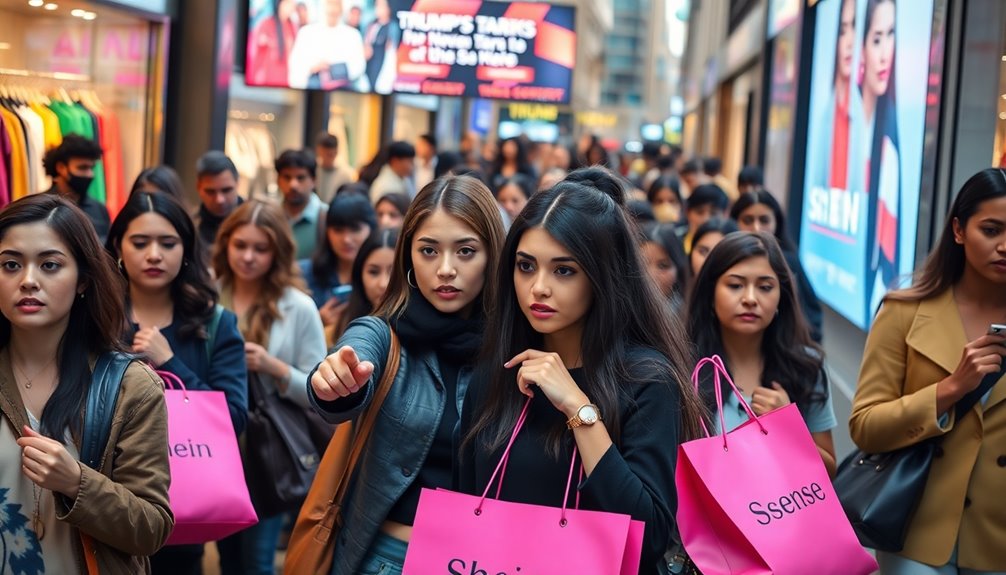As Shein and Ssense shoppers brace for the end of the “De Minimis” loophole on May 2, you might be feeling the anxiety of impending price hikes. Tariffs could soar up to 54%, making trendy outfits feel more like luxury purchases. Many shoppers are already reconsidering their spending habits, shifting toward more affordable and sustainable brands. The retail landscape is changing, and you’ll want to understand how this impacts your fashion choices and budget.
Key Takeaways
- The end of the “De Minimis” loophole on May 2 could lead to price hikes for Shein and Ssense shoppers, with tariffs possibly increasing to 54%.
- Financial strain from rising costs may cause consumers to rethink their fast fashion purchases and shift towards more affordable options.
- Shein faces intense pressure to keep prices competitive against U.S. brands as the market dynamics shift due to increased tariffs.
- Shoppers are increasingly looking for sustainable local brands, indicating a potential decline in loyalty to fast fashion retailers like Shein and Ssense.
- Economic policy changes regarding tariffs may redefine shopping experiences, affecting consumer choices and priorities in fashion purchases.

As the deadline for the end of the “de minimis” loophole approaches, shoppers at Shein and Ssense are bracing for potential price hikes that could reshape their buying habits. With the exemption set to end on May 2, the prospect of combined tariff rates soaring to 54% is making many of you reconsider your fashion choices.
For those who rely on affordable styles from Chinese retailers, this change could mean a significant increase in costs. You might already feel the anxiety creeping in as you realize that your budget may take a hit. The concern is valid; American households could see their spending habits shift dramatically if fast fashion prices rise. In fact, some estimates suggest that households could see an increase in their budgets by up to $2,100 due to these tariffs.
As fast fashion prices rise, many shoppers may feel the financial strain, prompting a shift in buying habits.
Suddenly, those trendy outfits you loved could become luxury items, forcing you to weigh your options more carefully. You’re not alone in this; many shoppers are already thinking twice about their purchases.
Retailers like Shein face tough challenges as they strive to keep prices competitive against traditional U.S. brands. The removal of the loophole could level the playing field for companies like Forever 21, which have struggled against lower-priced imports.
This shift might change the dynamics of the market, pushing you to explore alternatives or even local brands that offer sustainable options. As tariffs come into play, your shopping habits may evolve. You might find yourself becoming more price-sensitive, opting for items that won’t break the bank.
If brand loyalty was once a driving force, rising prices might lead you to reconsider. Understanding how you react to these changes is crucial for retailers hoping to adapt.
Ultimately, the balance between domestic interests and international trade relations is in flux. As you navigate this new landscape, expect to see how these economic policy shifts influence your choices and the broader market.
The upcoming changes could redefine your shopping experience, making it essential to stay informed.
Frequently Asked Questions
How Do Tariffs Affect Online Shopping Prices?
Tariffs can significantly affect online shopping prices by increasing the costs of imported goods.
When tariffs rise, retailers often pass those costs onto you, leading to higher prices for items you want.
Additionally, the elimination of the de minimis exemption means even small shipments may incur duties, further driving up costs.
You might find yourself paying more for electronics and clothing, and shipping delays could also affect your overall shopping experience.
What Items Are Most Impacted by Trump’s Tariffs?
Did you know that tariffs on Chinese products could reach a staggering 54%?
This will significantly impact fast-fashion items from retailers like Shein and Temu. Clothing, accessories, and household items you love might see price increases as retailers adjust their strategies.
Small-dollar shipments will also be affected due to the elimination of the de minimis loophole, making it more costly for you to shop online for these trendy items.
Are There Alternatives to Shein and Ssense?
If you’re searching for alternatives to Shein and SSENSE, you’ve got plenty of options!
Zara and H&M offer trendy styles at affordable prices, while Forever 21 caters to budget-conscious shoppers.
For sustainable choices, check out Reformation and Patagonia, which prioritize eco-friendly practices.
If luxury’s your thing, Moda Operandi and Farfetch deliver high-end fashion.
With these options, you can still stay stylish without sticking to just one brand!
How Can Shoppers Minimize Tariff Costs?
To minimize tariff costs, you can buy products before potential increases, which saves you money in the long run.
Supporting local businesses reduces reliance on imports, helping your community and avoiding tariffs.
Keep an eye out for discounts or promotions that retailers may offer to offset price hikes.
Additionally, consider exploring alternative shopping options from regions with lower tariffs, and monitor prices regularly to make strategic purchasing decisions.
What Is the History of Tariffs in the U.S.?
The history of tariffs in the U.S. dates back to 1789, when they were first used as a trade policy tool.
Over time, you’ve seen tariffs fluctuate between protectionism and free trade, impacting global trade dynamics.
Significant tariff policies, like those implemented during the Trump administration, have affected consumer prices and industries.
Ongoing tariffs continue to influence economic conditions, demonstrating their lasting impact on both domestic markets and international relations.
Conclusion
As shoppers scramble and stress over soaring prices, it’s clear that Trump’s tariffs have thrown a wrench into the wardrobe of many. Shein and Ssense enthusiasts are feeling the pinch, pondering purchases with a wary eye. The fashion frenzy is faltering, forcing folks to rethink their retail routines. So, stay savvy and stay informed! In this turbulent time, it’s crucial to navigate the nuances of the new normal and make mindful choices.










